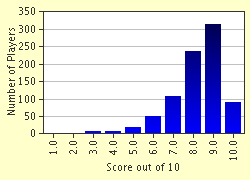Quiz Answer Key and Fun Facts
1. What is the outermost covering of the tooth structure?
2. Many people talk about having problems with their TMJ. What does TMJ stand for?
3. The field of dentistry that specializes in the straightening of 'crooked teeth' is _____.
4. The dentist starts to examine your teeth and comments that you have calculus. What does the dentist mean by calculus?
5. A root canal procedure involves what?
6. The dentist comments that your gingiva is inflamed. What is the gingiva?
7. Exodontia is a better term for what?
8. The dentist stares at an x-ray and says that you have "congenitally missing incisors." What does that mean?
9. Another name for "fang tooth" is ___ ?
10. The dentist has told you that your little 8-year-old needs "sealants" placed on his newly erupted 6-year molars. What is it that he wants to do?
Source: Author
molarman2276
This quiz was reviewed by FunTrivia editor
crisw before going online.
Any errors found in FunTrivia content are routinely corrected through our feedback system.

